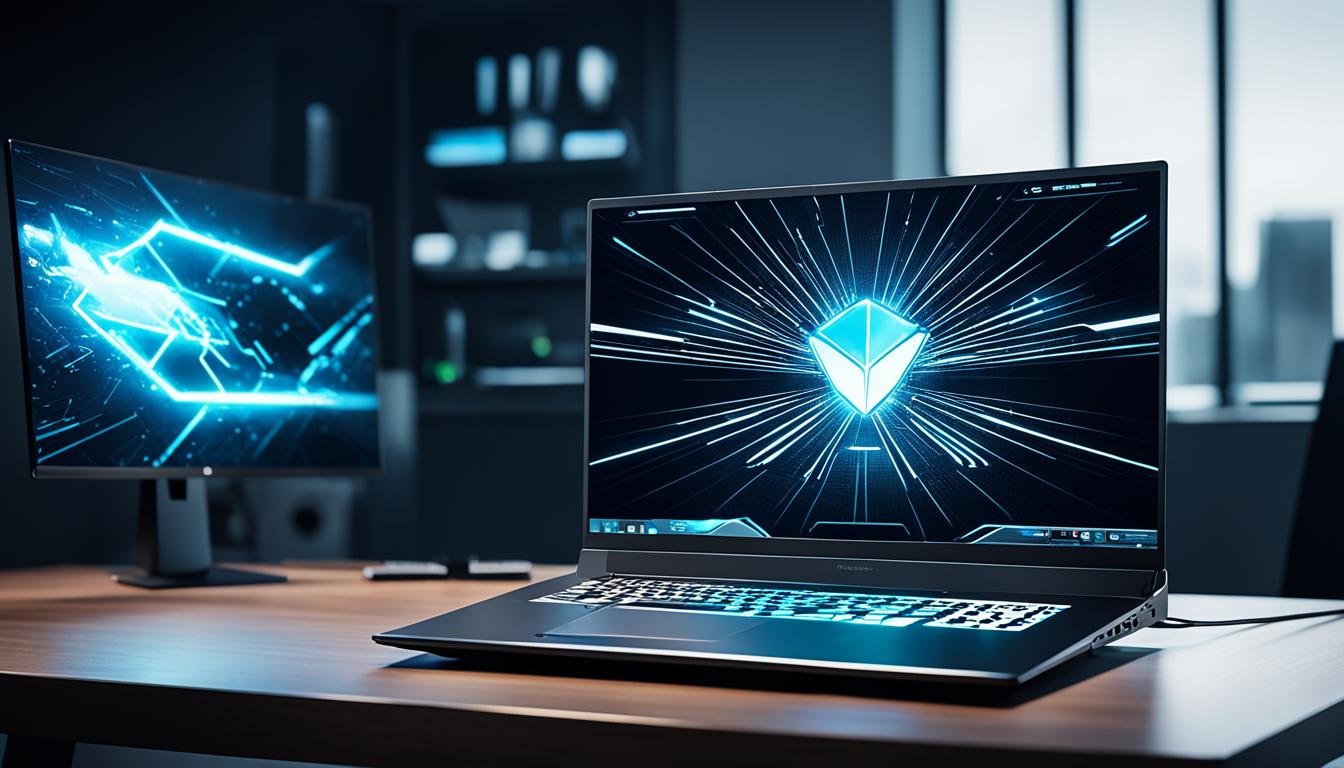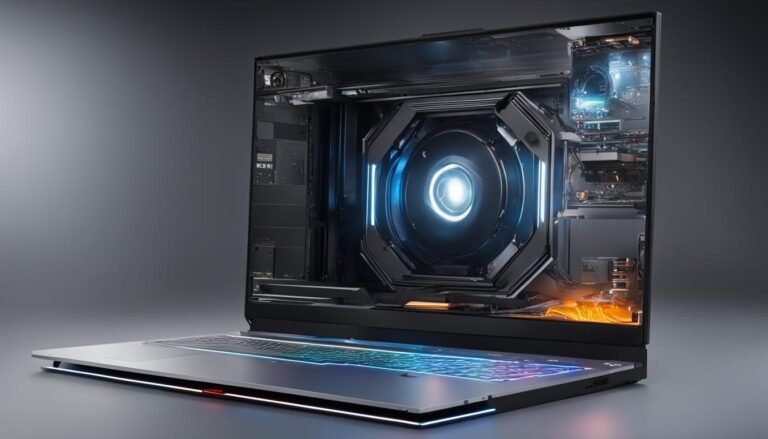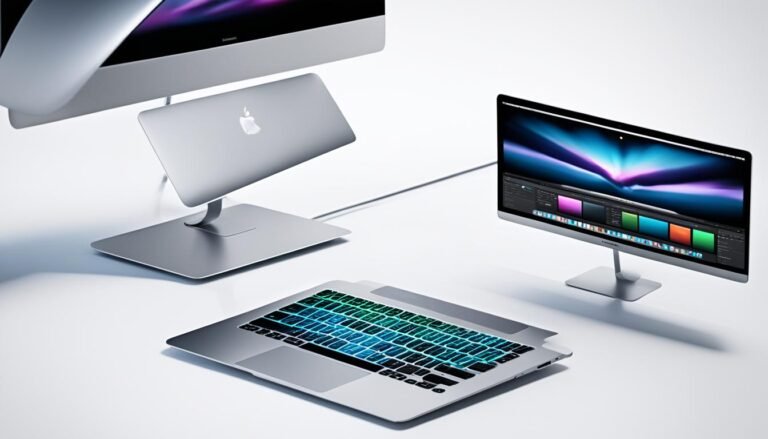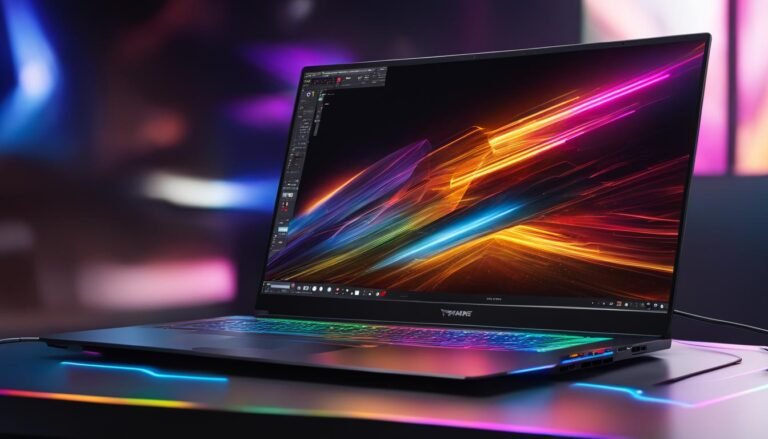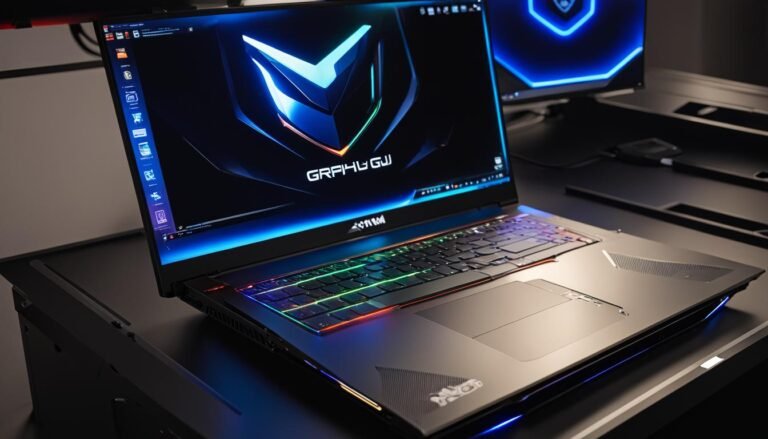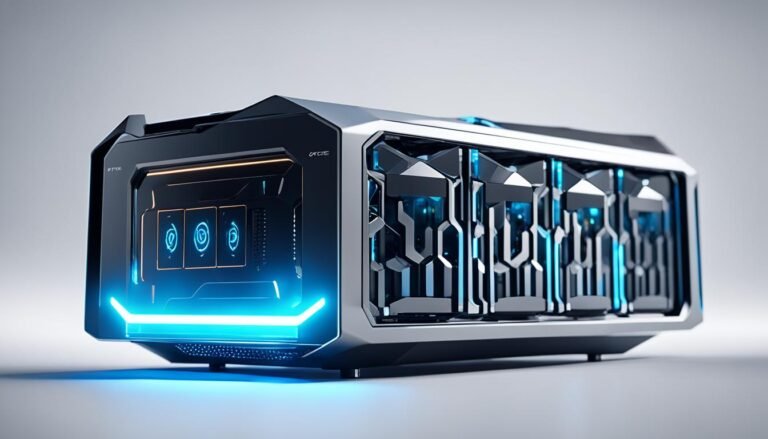Best External GPU with Thunderbolt for Laptops
Using an external graphics card with Thunderbolt is a game-changer for laptop users, whether you’re a gamer seeking enhanced gaming performance or a professional in need of powerful graphics for your work. In this article, we will explore the best external GPUs with Thunderbolt, examining their performance, compatibility, and price to help you make an informed decision.
Key Takeaways:
- External GPUs with Thunderbolt can significantly improve your laptop’s graphics power for gaming or professional work.
- They provide flexibility, allowing you to easily connect or disconnect the external GPU as needed.
- Consider factors such as compatibility, performance, and price when choosing an external GPU with Thunderbolt.
- The AMD Radeon RX 7600 and Nvidia RTX 4060 are great options for gaming, while the AMD RX 6750 XT and Nvidia RTX 4070 Ti excel in professional work.
- Stay informed about future developments in Thunderbolt technology, such as Thunderbolt 5 and USB4v2, to make the most out of your external GPU.
The Benefits of External GPUs with Thunderbolt
External GPUs with Thunderbolt offer numerous advantages for laptop users, providing a significant boost in graphics performance and enhancing the overall capabilities of your machine. Whether you’re a gamer or a professional relying on graphics-intensive software, incorporating a Thunderbolt-compatible external GPU can greatly improve your experience.
Here are some key benefits of using external GPUs with Thunderbolt:
- Improved Graphics Performance: One of the primary benefits of an external GPU with Thunderbolt is the ability to enhance graphics performance on your laptop. With a powerful external GPU, you can unlock the potential of your laptop, enabling smoother gameplay, faster rendering, and improved visual quality for graphics-intensive tasks.
- Flexibility and Portability: External GPUs with Thunderbolt offer the advantage of flexibility. You can easily connect or disconnect the external GPU as needed, allowing you to switch between using your laptop on the go and taking advantage of the enhanced graphics performance when plugged into the external GPU enclosure.
- High-Speed Data Transfer: Thunderbolt 3 and 4, the latest Thunderbolt versions, provide lightning-fast data transfer speeds. This high bandwidth allows for seamless communication between the external GPU and your laptop, ensuring smooth performance and minimal latency. Additionally, Thunderbolt 3 and 4 can handle multiple connections simultaneously, enabling you to connect multiple peripherals alongside your external GPU.
To visualize the benefits of external GPUs with Thunderbolt, here is a comparison table showcasing the advantages:
| Advantages of External GPUs with Thunderbolt | |
|---|---|
| Improved Graphics Performance | Enhance gameplay, rendering, and visual quality |
| Flexibility and Portability | Easily connect or disconnect the external GPU as needed |
| High-Speed Data Transfer | Lightning-fast communication between the external GPU and laptop |
With the benefits of improved graphics performance, flexibility, and high-speed data transfer, external GPUs with Thunderbolt offer a reliable solution for elevating your laptop’s graphics capabilities. Whether you’re a gaming enthusiast seeking enhanced gameplay or a professional in need of advanced graphics for your work, investing in a Thunderbolt-compatible external GPU can provide the power and versatility you require.
Factors to Consider When Choosing an External GPU with Thunderbolt
When selecting an external GPU with Thunderbolt, several important factors should be taken into consideration to ensure the best compatibility, performance, and value for your specific needs. These factors include:
- Compatibility: Ensure that the external GPU you choose is compatible with both your laptop and the Thunderbolt version it supports. Not all GPUs work seamlessly with every Thunderbolt port, so it’s essential to verify compatibility before making a purchase.
- Power Requirements: Consider the power requirements of the GPU you plan to use. Thunderbolt external GPUs generally require an additional power source due to their high-performance nature. Make sure that your laptop’s power supply is sufficient to handle both the GPU and other connected peripherals.
- Enclosure Size and Design: The size and design of the enclosure can significantly impact the overall usability and portability of your external GPU setup. Choose an enclosure that not only accommodates your chosen GPU but also aligns with your desired level of portability and aesthetics.
- Price: Set a budget for your external GPU purchase and consider the price range of available options. It’s important to strike a balance between performance and cost-effectiveness, ensuring that you get the most value for your investment.
By carefully evaluating these factors, you can make an informed decision and find an external GPU with Thunderbolt that meets your requirements and enhances your laptop’s graphics capabilities.

After considering these factors, you will be better equipped to choose the optimal external GPU with Thunderbolt for your specific needs, ensuring a seamless and powerful graphics experience.
Best eGPUs for Gaming with Thunderbolt
For gamers looking to take their gaming experience to the next level with an external GPU, there are several top options available. These eGPUs offer the power and features needed to enhance graphics performance and deliver a smooth gaming experience. Two standout choices for gaming with Thunderbolt are the AMD Radeon RX 7600 and the Nvidia RTX 4060.
1. AMD Radeon RX 7600
The AMD Radeon RX 7600 is an excellent choice for most gamers seeking solid 1080p gaming performance at an affordable price. This eGPU delivers impressive graphics capabilities, allowing for smooth gameplay and stunning visuals. It is compatible with Thunderbolt 3, ensuring seamless connectivity and high-speed data transfer. With its robust feature set and attractive price point, the AMD Radeon RX 7600 is a favorite among gaming enthusiasts.
2. Nvidia RTX 4060
The Nvidia RTX 4060 is another top contender for gaming with Thunderbolt. This eGPU offers DLSS support, which employs artificial intelligence to deliver enhanced image quality and improved performance. Gamers can enjoy higher frame rates and realistic visuals thanks to the RTX 4060’s strong ray tracing capabilities. With its advanced technology and superior graphics processing power, the Nvidia RTX 4060 is an excellent choice for demanding gamers.
Both the AMD Radeon RX 7600 and the Nvidia RTX 4060 provide exceptional performance for gaming with Thunderbolt. They offer the power, speed, and features needed to elevate your gaming experience and unlock the full potential of your laptop. Whether you prefer affordability, advanced visuals, or a combination of both, these eGPUs are sure to satisfy your gaming needs.
| eGPU | Performance | Features | Compatibility | Price |
|---|---|---|---|---|
| AMD Radeon RX 7600 | Excellent | 1080p gaming, affordability | Thunderbolt 3 | Affordable |
| Nvidia RTX 4060 | Outstanding | DLSS support, ray tracing | Thunderbolt 3 | Higher cost |
Best eGPUs for Professional Work with Thunderbolt
Professionals who require high-performance graphics for tasks such as video editing, 3D modeling, and rendering can benefit from an external GPU with Thunderbolt. These powerful devices provide the extra processing power needed to handle demanding professional graphics tasks.
1. AMD RX 6750 XT
The AMD RX 6750 XT is an excellent choice for professional work with Thunderbolt. With its high-performance architecture, this graphics card delivers exceptional performance for 1440p workloads. It offers excellent rendering speeds and smooth graphics performance, making it a popular option among professionals.

Image: Best eGPUs for Professional Work with Thunderbolt (AMD RX 6750 XT)
2. Nvidia RTX 4070 Ti
Another top choice for professional graphics tasks is the Nvidia RTX 4070 Ti. This graphics card is equipped with DLSS support and CUDA core acceleration, making it a powerhouse for demanding professional applications. With its impressive rendering capabilities, it can handle complex visual tasks with ease.
Both the AMD RX 6750 XT and Nvidia RTX 4070 Ti offer exceptional performance and a range of features that are specifically designed to meet the needs of professionals. Whether you’re a video editor, 3D artist, or graphic designer, these eGPUs can significantly enhance your workflow.
Performance Comparison of External GPUs with Thunderbolt
When it comes to the performance of external GPUs with Thunderbolt, there are several key factors to consider for an accurate assessment. The GPU model, Thunderbolt version, and other hardware specifications play a crucial role in determining the capabilities of these external graphics solutions. To gain valuable insights into their performance, benchmarks and real-world testing are essential.
To begin with, the GPU model is a significant determining factor in the overall performance of an external GPU with Thunderbolt. Different models have varying levels of power and efficiency, which directly impact their ability to handle demanding tasks. Whether you’re focusing on gaming or professional work, it’s crucial to choose a GPU that aligns with your specific workload requirements. This ensures smooth performance and optimal utilization of your resources.
The Thunderbolt version also plays a significant role in the performance of external GPUs. Thunderbolt 3 and Thunderbolt 4 provide high-speed data transfer and display connectivity capabilities. However, it’s important to note that these versions have bandwidth limitations that may affect the performance of your external GPU. Understanding these limitations and choosing a compatible setup is crucial to maximize performance.
Real-world benchmarks are an excellent way to gauge the performance of external GPUs with Thunderbolt. These benchmarks provide objective and comparative data, allowing users to make informed decisions. By examining the results of various benchmark tests, you can determine how well an external GPU performs in different scenarios, such as gaming or professional tasks.
When comparing the performance of external GPUs, it’s important to consider a range of benchmarks and real-world applications that are relevant to your intended use. This ensures that you have a comprehensive understanding of the capabilities and limitations of different GPUs. A well-rounded performance comparison will provide valuable insights to guide your decision-making process.
Ultimately, the goal is to select an external GPU with Thunderbolt that can deliver the desired performance for your unique requirements. Whether you’re a gamer looking for high frame rates or a professional in need of enhanced graphics capabilities, understanding the performance nuances of different external GPUs will pave the way for an optimal computing experience.
Example Benchmarks:
AMD Radeon RX 7600: Average FPS in popular games – 75
Nvidia RTX 4060: Average FPS in popular games – 85
AMD RX 6750 XT: Rendering time for 3D modeling – 2 minutes
Nvidia RTX 4070 Ti: Rendering time for 3D modeling – 1.5 minutes
As evident from the example benchmarks, there can be notable performance differences between different external GPUs. It’s essential to consider the specific tasks and applications you require the GPU for, as each GPU excels in different areas. These benchmarks can serve as a starting point for your research and decision-making process.
By carefully considering the performance comparison of external GPUs with Thunderbolt, you can make an informed choice that aligns with your needs and budget. Whether you prioritize gaming, professional work, or a combination of both, understanding the capabilities and limitations of different GPUs will empower you to unlock the full potential of your laptop’s graphics performance.
Thunderbolt Compatibility and Bandwidth Limitations for eGPUs
Using an external GPU with Thunderbolt can significantly enhance the graphics performance of your laptop. However, it’s crucial to consider the compatibility and bandwidth limitations associated with Thunderbolt when choosing an eGPU.
Not all laptops and Thunderbolt versions are compatible with external GPUs. Therefore, before investing in an eGPU, ensure that your laptop’s Thunderbolt port supports eGPU connectivity. Additionally, check the compatibility of the eGPU enclosure with your laptop’s Thunderbolt version.
Thunderbolt 3 and 4 offer high-speed data transfer and display connectivity, making them ideal for eGPU setups. However, it’s important to note that both Thunderbolt 3 and 4 have bandwidth limitations that can impact eGPU performance. These limitations may result in reduced graphics performance compared to a dedicated desktop GPU.
When considering an eGPU, assess your performance requirements and determine if the bandwidth limitations of Thunderbolt 3 or 4 will meet your needs. If you require the highest performance for gaming or professional work, it’s advisable to opt for a dedicated desktop with a PCIe connection instead.
Considerations for Thunderbolt eGPU Compatibility:
- Ensure your laptop has a Thunderbolt port that supports eGPU connectivity.
- Check the compatibility of the eGPU enclosure with your laptop’s Thunderbolt version.
- Verify if your laptop’s Thunderbolt port provides sufficient power delivery for the eGPU.
- Research compatibility lists and user experiences for specific eGPU models and laptop configurations.
It’s vital to thoroughly research and understand the Thunderbolt compatibility and bandwidth limitations before investing in an eGPU. This will help you make an informed decision and optimize your graphics performance.
Understanding Thunderbolt compatibility is essential for ensuring a seamless eGPU setup. Keep in mind the bandwidth limitations of Thunderbolt 3 and 4 and their impact on eGPU performance. By selecting a compatible eGPU and considering your performance requirements, you can harness the power of Thunderbolt for a superior graphics experience.
Setting Up and Installing an External GPU with Thunderbolt
Setting up and installing an external GPU with Thunderbolt is a straightforward process that requires a few essential steps. By following these steps, you can unleash the full graphics potential of your laptop. Before beginning the setup, ensure that your laptop supports external GPUs and that you have a Thunderbolt port available.
Step 1: Connect the eGPU Enclosure
Start by connecting the eGPU enclosure to your laptop’s Thunderbolt port using the provided Thunderbolt cable. Make sure the connection is secure and properly aligned. The Thunderbolt port may be located on either side or the back of your laptop, so refer to your laptop’s user manual for the exact location.
Step 2: Install the Necessary Drivers
Once the eGPU enclosure is connected, you’ll need to install the necessary drivers for the external GPU. These drivers allow your laptop to communicate with the GPU and take advantage of its performance capabilities. Check the manufacturer’s website for the latest drivers compatible with your specific GPU model and Thunderbolt version.
Step 3: Configure the eGPU Settings
After installing the drivers, you’ll need to configure the eGPU settings on your laptop. This can usually be done through the GPU control software provided by the manufacturer. The software allows you to specify how your laptop should utilize the external GPU for graphics-intensive tasks. Adjust the settings according to your preferences and workload requirements.
It’s important to note that during the setup process, you may need to restart your laptop or go through the device detection process. Follow the on-screen instructions and prompts to complete the setup successfully.
Once the setup is complete, you can start enjoying the enhanced graphics performance provided by the external GPU. Whether you’re gaming or engaging in professional graphics tasks, the Thunderbolt-enabled external GPU can significantly elevate your laptop’s capabilities.
Now that you have successfully set up and installed an external GPU with Thunderbolt, you can immerse yourself in a world of improved graphics performance and expand the possibilities of your laptop.
Maintenance and Troubleshooting for External GPUs with Thunderbolt
Just like any other hardware component, external GPUs with Thunderbolt require regular maintenance to ensure optimal performance. By following a few maintenance practices and troubleshooting common issues, you can keep your Thunderbolt external GPU running smoothly and avoid any potential disruptions to your gaming or professional tasks.
Maintenance Tips
Here are some essential maintenance tips for your Thunderbolt external GPU:
- Keep the GPU and Enclosure Clean: Regularly clean the external GPU and its enclosure to prevent dust buildup that can affect performance. Use compressed air or a soft brush to gently remove any dust or debris from the GPU and its cooling fans.
- Update Drivers and Firmware: Stay updated with the latest drivers and firmware for both your external GPU and the Thunderbolt connection. Manufacturers often release updates to improve compatibility, performance, and stability. Check their websites regularly or use their software applications to ensure you have the most recent versions.
- Monitor Temperatures: Pay attention to the temperature of your external GPU during intensive tasks. High temperatures can lead to thermal throttling and performance issues. Consider using monitoring software to keep track of GPU temperatures and adjust fan settings if necessary.
Troubleshooting Common Issues
“My external GPU isn’t working properly. What should I do?”
If you encounter issues with your Thunderbolt external GPU, consider the following troubleshooting steps:
- Check Thunderbolt Compatibility: Verify that your laptop and Thunderbolt port are compatible with external GPUs. Ensure that your Thunderbolt version supports eGPU functionality. Refer to your laptop’s documentation or contact the manufacturer for detailed information.
- Disconnect and Reconnect: Disconnect and reconnect your external GPU to the Thunderbolt port. Sometimes, a loose or improper connection can cause issues. Ensure that all cables are securely attached and try connecting the eGPU to a different Thunderbolt port (if available).
- Driver and Firmware Updates: Update the drivers and firmware for your external GPU and the Thunderbolt connection. Outdated software can result in compatibility issues and suboptimal performance. Check the manufacturer’s website for the latest updates.
- Power Cycle: Perform a power cycle by shutting down your laptop, disconnecting the eGPU, and removing its power source. Wait for a few minutes, then reconnect the eGPU and power it back on. Restart your laptop and check if the issue is resolved.
- Reinstall Drivers: Uninstall and reinstall the drivers for your external GPU. Use the manufacturer’s official uninstallation tool or utility to ensure a clean installation. Then, download and install the latest drivers from their website.
If you’ve followed these troubleshooting steps and are still experiencing problems with your Thunderbolt external GPU, consider reaching out to the manufacturer’s support team for further assistance.
| Issue | Troubleshooting Steps |
|---|---|
| External GPU not detected |
|
| Low GPU performance |
|
| System crashes or instability |
|
Future Developments in External GPUs with Thunderbolt
The field of external GPUs with Thunderbolt is constantly evolving, with exciting future developments and advancements on the horizon. Thunderbolt 3 and 4 have already revolutionized the external GPU market, offering fast data transfer speeds and versatile connectivity options. But what can we expect in the near future?
One of the highly anticipated future developments is the release of Thunderbolt 5. Thunderbolt 5 is expected to bring even higher bandwidth and improved performance for eGPUs. With increased bandwidth, users can expect enhanced graphics capabilities and smoother gameplay, making Thunderbolt 5 eGPUs a game-changer for both gamers and professionals.
Another development to watch out for is the integration of Thunderbolt technology into USB4v2. USB4v2 is the next generation of universal connectivity, offering high-speed data transfer and compatibility across various devices. This integration will further expand the reach of Thunderbolt eGPUs, making them more accessible and versatile.
With Thunderbolt 5 and USB4v2 on the horizon, it’s crucial for laptop users to stay informed about these upcoming developments. These future iterations of Thunderbolt will undoubtedly bring significant advancements in external GPU performance, compatibility, and user experience.
Stay tuned for the latest news and updates regarding Thunderbolt external GPUs. As the technology evolves, there will be more options and possibilities for users looking to enhance their laptop’s graphics power.
Future Thunderbolt eGPU Developments
| Development | Description |
|---|---|
| Thunderbolt 5 | Expected to deliver higher bandwidth and improved performance for eGPUs, revolutionizing the external GPU market. |
| Integration with USB4v2 | The integration of Thunderbolt technology into USB4v2 will expand the reach of Thunderbolt eGPUs, making them more accessible and versatile. |
As the table shows, Thunderbolt 5 and USB4v2 will bring exciting advancements to the realm of Thunderbolt eGPUs. These developments will undoubtedly shape the future of external GPUs, offering users even more power and performance for their laptops.
Conclusion
In conclusion, external GPUs with Thunderbolt provide a powerful and flexible solution for enhancing the graphics performance of laptops. Whether you’re a gamer or a professional, there are numerous options available that cater to different needs and budgets. It is crucial to consider factors such as compatibility, performance, and price when selecting an external GPU with Thunderbolt. By choosing the right setup, you can unlock the full potential of your laptop and elevate your gaming experience or professional graphics tasks.
External GPUs with Thunderbolt offer several benefits, including improved graphics performance, flexibility, and high-speed data transfer. They enable you to play demanding games, work on graphic-intensive tasks, and connect multiple peripherals seamlessly. Thunderbolt 3 and Thunderbolt 4 provide fast and versatile connectivity, allowing you to experience smooth gameplay and faster data transfer rates.
When choosing an external GPU with Thunderbolt, it is important to consider the compatibility with your laptop and Thunderbolt version, power requirements, enclosure size, and price. Ensuring that the GPU is compatible with your laptop’s Thunderbolt port and can deliver the desired performance is essential for a seamless user experience.
With the rapid advancements in the field, future developments in external GPUs with Thunderbolt, such as Thunderbolt 5 and USB4v2, promise even higher bandwidth and improved performance. Staying informed about these developments can help you make better purchasing decisions when it comes to external GPUs.
FAQ
Can I use an external GPU with Thunderbolt on my laptop?
Yes, you can use an external GPU with Thunderbolt on laptops that have a Thunderbolt 3 or Thunderbolt 4 port.
What are the benefits of using an external GPU with Thunderbolt?
Using an external GPU with Thunderbolt allows for improved graphics performance, flexibility, high-speed data transfer, and connection to multiple peripherals.
What factors should I consider when choosing an external GPU with Thunderbolt?
You should consider the compatibility with your laptop and Thunderbolt version, power requirements, size and design of the enclosure, and price.
What are the best eGPUs for gaming with Thunderbolt?
The AMD Radeon RX 7600 and Nvidia RTX 4060 are excellent choices for gamers, offering solid gaming performance at affordable prices.
What are the best eGPUs for professional work with Thunderbolt?
The AMD RX 6750 XT and Nvidia RTX 4070 Ti are powerful options for professionals, providing excellent performance for tasks such as video editing and 3D modeling.
How do external GPUs with Thunderbolt compare in terms of performance?
Performance can vary depending on the GPU model, Thunderbolt version, and hardware specifications. Benchmarks and real-world testing can provide insights into their capabilities.
Are all laptops and Thunderbolt versions compatible with external GPUs?
Not all laptops and Thunderbolt versions are compatible. Thunderbolt 3 and 4 have bandwidth limitations that can affect eGPU performance, so compatibility should be checked.
How do I set up and install an external GPU with Thunderbolt?
The setup involves connecting the eGPU enclosure to the Thunderbolt port, installing drivers, and configuring the settings following the manufacturer’s instructions.
How do I maintain and troubleshoot an external GPU with Thunderbolt?
Regular maintenance includes keeping the GPU and enclosure clean, updating drivers and firmware, as well as troubleshooting any issues that may arise.
What future developments can we expect in external GPUs with Thunderbolt?
Thunderbolt 5 and USB4v2 are expected to bring higher bandwidth and improved performance for eGPUs, offering even more potential in the future.
